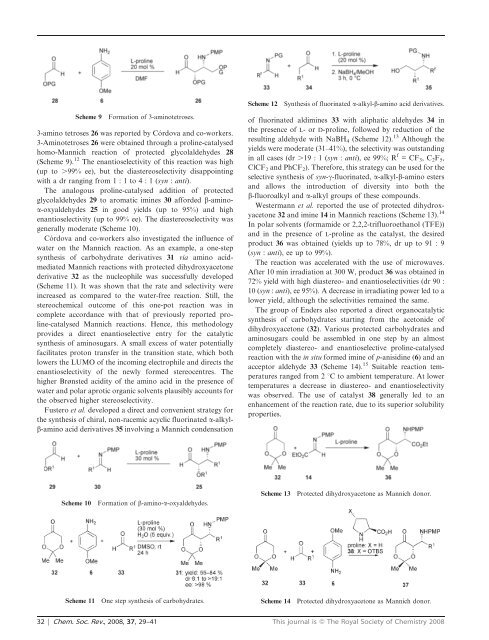Organocatalysed asymmetric Mannich reactions
Organocatalysed asymmetric Mannich reactions
Organocatalysed asymmetric Mannich reactions
You also want an ePaper? Increase the reach of your titles
YUMPU automatically turns print PDFs into web optimized ePapers that Google loves.
Scheme 12<br />
Synthesis of fluorinated a-alkyl-b-amino acid derivatives.<br />
Scheme 9<br />
Formation of 3-aminotetroses.<br />
3-amino tetroses 26 was reported by Córdova and co-workers.<br />
3-Aminotetroses 26 were obtained through a proline-catalysed<br />
homo-<strong>Mannich</strong> reaction of protected glycolaldehydes 28<br />
(Scheme 9). 12 The enantioselectivity of this reaction was high<br />
(up to .99% ee), but the diastereoselectivity disappointing<br />
with a dr ranging from 1 : 1 to 4 : 1 (syn : anti).<br />
The analogous proline-catalysed addition of protected<br />
glycolaldehydes 29 to aromatic imines 30 afforded b-aminoa-oxyaldehydes<br />
25 in good yields (up to 95%) and high<br />
enantioselectivity (up to 99% ee). The diastereoselectivity was<br />
generally moderate (Scheme 10).<br />
Córdova and co-workers also investigated the influence of<br />
water on the <strong>Mannich</strong> reaction. As an example, a one-step<br />
synthesis of carbohydrate derivatives 31 via amino acidmediated<br />
<strong>Mannich</strong> <strong>reactions</strong> with protected dihydroxyacetone<br />
derivative 32 as the nucleophile was successfully developed<br />
(Scheme 11). It was shown that the rate and selectivity were<br />
increased as compared to the water-free reaction. Still, the<br />
stereochemical outcome of this one-pot reaction was in<br />
complete accordance with that of previously reported proline-catalysed<br />
<strong>Mannich</strong> <strong>reactions</strong>. Hence, this methodology<br />
provides a direct enantioselective entry for the catalytic<br />
synthesis of aminosugars. A small excess of water potentially<br />
facilitates proton transfer in the transition state, which both<br />
lowers the LUMO of the incoming electrophile and directs the<br />
enantioselectivity of the newly formed stereocentres. The<br />
higher Brønsted acidity of the amino acid in the presence of<br />
water and polar aprotic organic solvents plausibly accounts for<br />
the observed higher stereoselectivity.<br />
Fustero et al. developed a direct and convenient strategy for<br />
the synthesis of chiral, non-racemic acyclic fluorinated a-alkylb-amino<br />
acid derivatives 35 involving a <strong>Mannich</strong> condensation<br />
of fluorinated aldimines 33 with aliphatic aldehydes 34 in<br />
the presence of L- orD-proline, followed by reduction of the<br />
resulting aldehyde with NaBH 4 (Scheme 12). 13 Although the<br />
yields were moderate (31–41%), the selectivity was outstanding<br />
in all cases (dr .19 : 1 (syn : anti), ee 99%; R f =CF 3 ,C 2 F 5 ,<br />
ClCF 2 and PhCF 2 ). Therefore, this strategy can be used for the<br />
selective synthesis of syn-c-fluorinated, a-alkyl-b-amino esters<br />
and allows the introduction of diversity into both the<br />
b-fluoroalkyl and a-alkyl groups of these compounds.<br />
Westermann et al. reported the use of protected dihydroxyacetone<br />
32 and imine 14 in <strong>Mannich</strong> <strong>reactions</strong> (Scheme 13). 14<br />
In polar solvents (formamide or 2,2,2-trifluoroethanol (TFE))<br />
and in the presence of L-proline as the catalyst, the desired<br />
product 36 was obtained (yields up to 78%, dr up to 91 : 9<br />
(syn : anti), ee up to 99%).<br />
The reaction was accelerated with the use of microwaves.<br />
After 10 min irradiation at 300 W, product 36 was obtained in<br />
72% yield with high diastereo- and enantioselectivities (dr 90 :<br />
10 (syn : anti), ee 95%). A decrease in irradiating power led to a<br />
lower yield, although the selectivities remained the same.<br />
The group of Enders also reported a direct organocatalytic<br />
synthesis of carbohydrates starting from the acetonide of<br />
dihydroxyacetone (32). Various protected carbohydrates and<br />
aminosugars could be assembled in one step by an almost<br />
completely diastereo- and enantioselective proline-catalysed<br />
reaction with the in situ formed imine of p-anisidine (6) and an<br />
acceptor aldehyde 33 (Scheme 14). 15 Suitable reaction temperatures<br />
ranged from 2 uC to ambient temperature. At lower<br />
temperatures a decrease in diastereo- and enantioselectivity<br />
was observed. The use of catalyst 38 generally led to an<br />
enhancement of the reaction rate, due to its superior solubility<br />
properties.<br />
Scheme 10<br />
Formation of b-amino-a-oxyaldehydes.<br />
Scheme 13<br />
Protected dihydroxyacetone as <strong>Mannich</strong> donor.<br />
Scheme 11<br />
One step synthesis of carbohydrates.<br />
Scheme 14<br />
Protected dihydroxyacetone as <strong>Mannich</strong> donor.<br />
32 | Chem. Soc. Rev., 2008, 37, 29–41 This journal is ß The Royal Society of Chemistry 2008
















